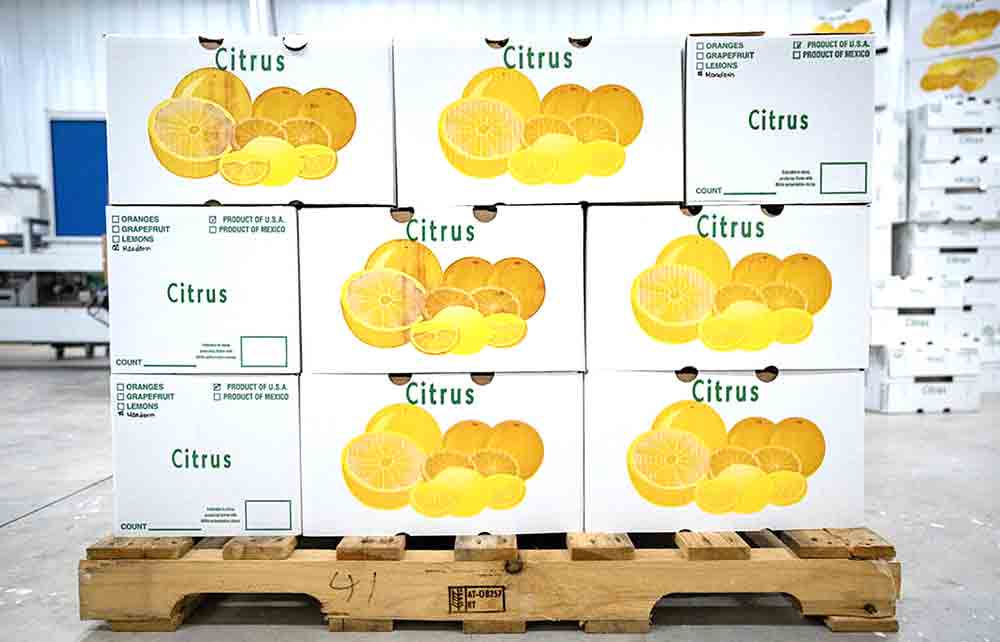 Harvest quality and quantities for Texas citrus producers have been up this season after multiple years of weather-related setbacks. Challenges still remain, but the season has provided optimism to citrus growers. Texas A&M AgriLife photo by Sam Craft
Harvest quality and quantities for Texas citrus producers have been up this season after multiple years of weather-related setbacks. Challenges still remain, but the season has provided optimism to citrus growers. Texas A&M AgriLife photo by Sam Craft
By Paul Schattenberg
Texas A&MAgriLife ExtensionCommunications Specialist
The Texas citrus crop quality and quantity was better than expected following multiple seasons of weather-related setbacks, according to a Texas A&M AgriLife Extension Service expert. Texas is the third largest citrus producer in the U.S., with the total economic impact of the citrus industry to the state exceeding $300 million annually. With increased fruit prices, cash receipts for citrus farmers recently exceeded $200 million. The Texas citrus industry is almost completely located in the Lower Rio Grande Valley, with most of the acreage in Hidalgo County and the remainder in Cameron and Willacy counties. The industry has faced numerous challenges in recent years, including Hurricane Hanna in 2020, winter storm Uri in early 2021, and droughts in both 2022 and 2023. Even a few cold-weather snaps in mid-January of this year brought several hours of sustained below-freezing temperatures to the region.
Effects of winter storm Uri
After Uri, Texas grapefruit production was at about 1.6 million boxes for the 2021-2022 season, down 33% from the previous year’s final production of 2.4 million boxes. Orange production was about 400,000 boxes, down 62% from the previous year’s production. Juan Anciso, Ph.D., AgriLife Extension vegetable specialist and associate head of the Department of Horticultural Sciences based at the Texas A&M AgriLife Research and Extension Center in Weslaco, said many producers have been worried there may be a repeat of Uri, so either they have decided not to replant citrus or have abstained from expanding their citrus acreage.
“The extended winter freeze of 2021 effectively decimated the citrus crop, losing 2,400-3,000 acres of the 24,000 acres of citrus planted that year,” Anciso said. “We were fortunate in that the few freezes we had earlier this year didn’t do any appreciable damage to the citrus crops.”
The current Rio Grande Valley citrus status
Related Articles
In spite of the challenges of recent years, Anciso said this year’s citrus crop production is looking up. He said last year a total of 4.1 million fresh 40-pound boxes of grapefruit and oranges were produced, with 2.4 million boxes being grapefruit and the remainder being oranges. “The 2023-2024 crop is off to a good start,” Anciso said. “We have already begun to harvest oranges and grapefruit, and the quality and yield are both looking really good at this point. There may be as much as a 20% increase over the last year’s production in these two crops.” Other small-production citrus in the Rio Grande Valley, such as Persian limes and tangerines, appear to be unaffected by quality issues associated with last year’s drought, he said. “There also has not been much of an issue with plant disease, including citrus greening, up to this point,” Anciso said. “The commercial citrus industry has taken an aggressive approach to curtailing citrus greening, and it looks like their efforts are paying off.”
What about water?
The future of the crop, however, will continue to depend on water availability. Citrus production is entirely dependent on the availability of irrigation water, which has been a longtime concern for the citrus industry in South Texas. A recent report by Texas A&M’s Center for North American Studies, CNAS, analyzed the economic impact of the worst-case scenario of a complete absence of irrigation water in the Lower Rio Grande Valley. Irrigation water shortages in the region have occurred since the 1990s and have been exacerbated since 1992 when Mexico began undersupplying the average minimum annual amount of water into the Rio Grande as required by a 1944 treaty.
“This water undersupply continues today,” said Luis Ribera, Ph.D., AgriLife Extension specialist in the Department of Agricultural Economics and CNAS director. The water deficit for the current five-year cycle that began on Oct. 25, 2020 was 673,892 acre-feet as of Dec. 9. This represents the second largest irrigation water deficit in the last three decades. “The past 30-plus years have demonstrated a trend toward fewer and fewer acre-feet of irrigation water available to the Lower Rio Grande Valley area,” Ribera said. Ribera said irrigation continues to be a concern for citrus growers who have struggled to supply recovering citrus with adequate water and face uncertain water availability in the future.
The future of citrusin the Lower Rio Grande Valley
Dale Murden, president of Texas Citrus Mutual, an association representing citrus growers, said he estimates citrus production in the Lower Rio Grande Valley to be at only about 60% of what it was before Uri. “We’re still trying to recover from the tree loss and damage from that winter storm, and many producers have been skeptical about replanting,” Murden said. However, he said, this year things are looking good for the citrus industry. “Citrus production is up, the current fruit quality is excellent, and prices have remained high, all of which are good for the producer,” he said. Murden, who has been in the citrus industry long enough to remember the trials and tribulations of the past 40-plus years, said he is still optimistic about Texas citrus. “Over the years, there have been issues with the weather, irrigation water and other challenges to the citrus industry, but in production agriculture you’ve got to be optimistic,” he said.
You are a guest
or post as a guest
Be the first to comment.

